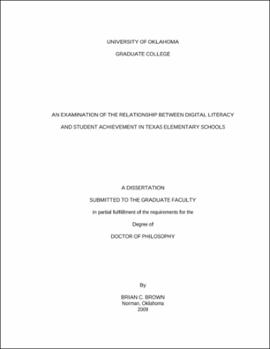| dc.contributor.advisor | Maiden, Jeffrey | |
| dc.creator | Brown, Brian C. | |
| dc.date.accessioned | 2019-04-27T21:23:44Z | |
| dc.date.available | 2019-04-27T21:23:44Z | |
| dc.date.issued | 2009 | |
| dc.identifier | 9914700302042 | |
| dc.identifier.uri | https://hdl.handle.net/11244/318573 | |
| dc.description.abstract | The proponents of digital literacy have been advocating its use in our schools and classrooms for a number of years. However, the empirical evidence on the impact of digital literacy on teaching and learning is nearly nonexistent. Therefore, this study was conducted to provide evidence of the effects of digital literacy skills instruction on student achievement. | |
| dc.description.abstract | There were three research questions that were used to guide the organization of this study. The first question sought to determine the level of digital literacy present in schools based upon their state accountability rating. Statistically significant differences between digital literacy levels of students according to their state accountability rating were investigated in the second question. The third question examined the statistically significant changes in elementary students' levels of digital literacy over a period of time. | |
| dc.description.abstract | The Texas Campus School Technology and Readiness Chart (STaR) was utilized, in part, as an indicator of the levels of digital literacy taught within schools. This was achieved by identifying and isolating several variables within the chart that contained levels that exemplified the theory of digital literacy. The key areas utilized from the Texas STaR Chart were patterns of classroom use, frequency/design of instructional setting using digital content, content area connections, and on-line learning. | |
| dc.description.abstract | The STaR Chart data were compared with data taken from the Accountability Rating System for Texas Public Schools and Districts for state elementary schools. The Texas Accountability Rating System is calculated, for elementary schools, entirely on student achievement on standardized tests. This study reviewed the STaR Chart and state accountability data for 3,518 elementary schools in Texas. By utilizing data obtained from these data sources, a relationship between digital literacy and student achievement was suggested. | |
| dc.format.extent | 158 pages | |
| dc.format.medium | application.pdf | |
| dc.language | en_US | |
| dc.relation.requires | Adobe Acrobat Reader | |
| dc.subject | Computer literacy--Study and teaching (Elementary)--Case studies | |
| dc.subject | Computer literacy--Study and teaching (Elementary)--Texas | |
| dc.title | An Examination of the Relationship Between Digital Literacy and Student Achievement in Texas Elementary Schools | |
| dc.type | text | |
| dc.type | document | |
| dc.thesis.degree | Ed.D. | |
| ou.group | Jeannine Rainbolt College of Education::Department of Educational Leadership and Policy Studies | |
